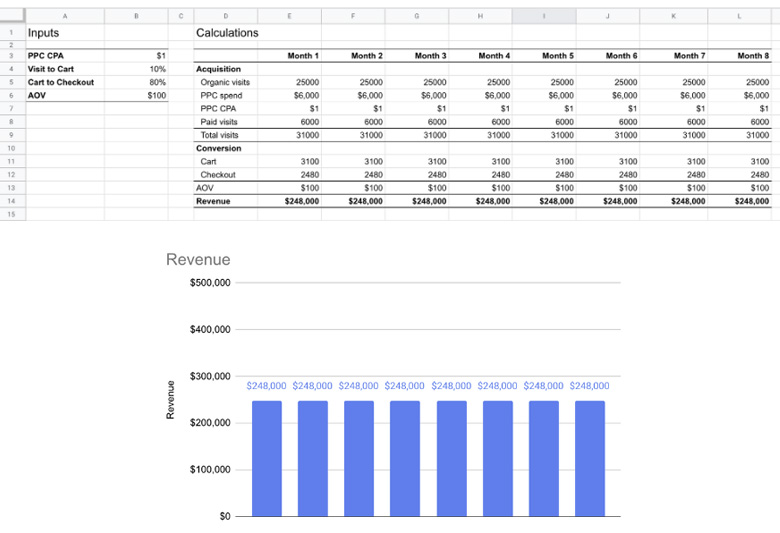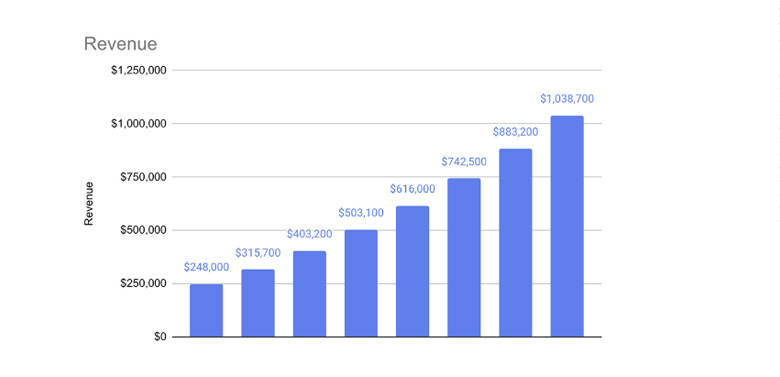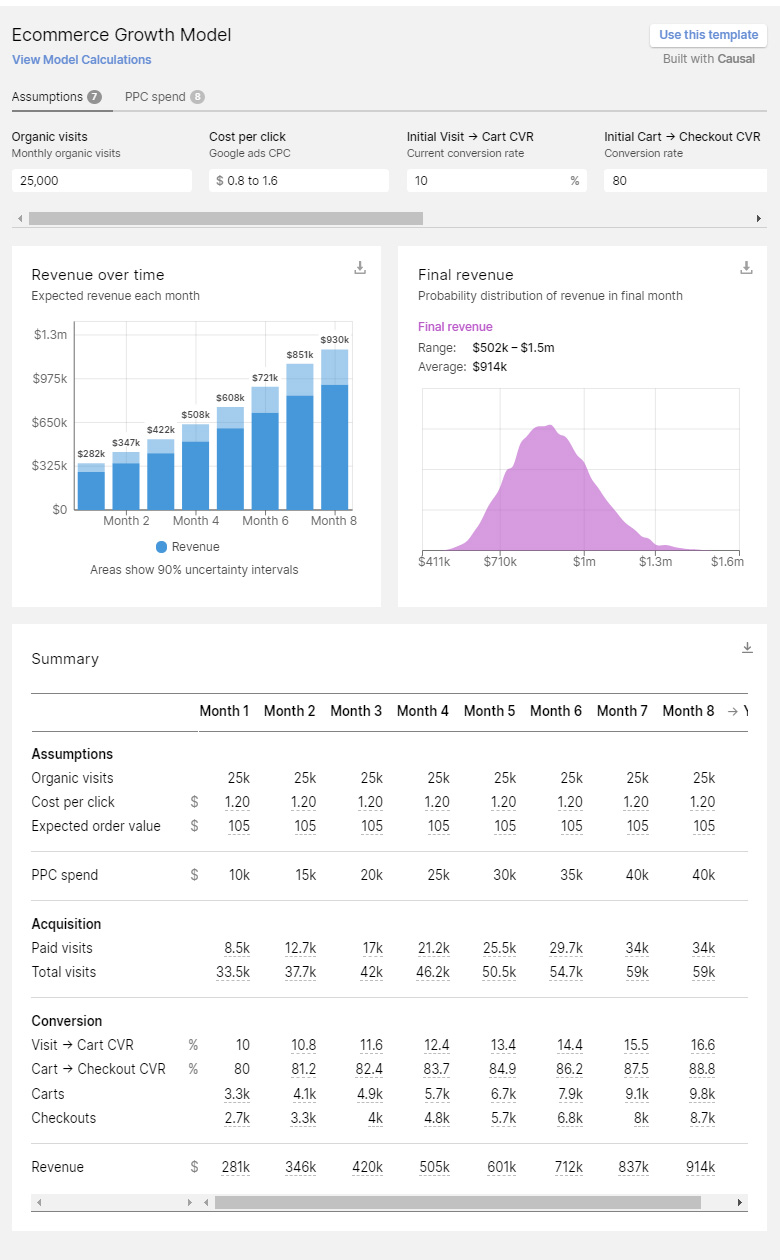Let’s suppose you’re leading the PPC strategy for a new ecommerce client. They’ve tasked you with helping them hit $1m monthly revenue by the end of the year.
You know a bit about their business already: they did $250k in revenue last month, and the average customer spends $100 on their store. This is a good starting point, but now you need to figure out how to get them to $1m.
The first thing you need to understand is whether this goal is even possible — you need an achievable goal to set the project up for success, and to set realistic expectations for your client.
If the goal is indeed possible, you’ll now want to know whether it’s probable — are you actually likely to hit it?
This is where a growth model can come in handy — a set of numbers and calculations that can help you answer questions like “is this possible?” and “is this probable?”, and help you “show your workings” to the client so that they understand your plan.
Here’s how you might set up a growth model.
Model A: top-down
Last month, the client had 2,500 customers spending an average of $100 each, for $250k total revenue, and they want to hit $1m in monthly revenue by the end of the year. So, you need to 4x their business, and you have 6 months to do it.
With a bit of number-crunching, you might end up with a model like this:

To get to $1m, you’ll need to grow their revenue by ~25% per month over the next 7 months.
This is interesting, but not terribly useful —
- 25% MoM growth might be possible for some businesses but not others. Which category does this ecommerce company fall into?
- Where will all these new users actually come from?
- How much will you have to spend to acquire these new users?
This top-down model produces a target — 25% MoM revenue growth. To figure out how to hit it, you’ll need a bottom-up approach.
Model B: bottom-up
A bottom-up model should be centered around the customer’s journey and the points in that journey that you can actually influence. Acquisition and conversion are the important steps for this ecommerce business.
Here’s what they might look like:
- Acquisition
- Organic visitors
- PPC spend
- PPC cost per click
- Conversion
- Visitor → Cart conversion rate
- Cart → Checkout conversion rate
- Order value
Each variable above is granular enough that you can make an effort to directly influence it — if you want to increase paid visitors, you could spend more on ads. If you want to increase Cart → Checkout conversion, you can try reducing friction. If you want to increase order value, you can experiment with promotions.
By doing some simple calculations, you can create a simple model that represents the variables above. And to figure out the current values for each variable, you can get the latest numbers from the client.

You’ll know that your model is reasonable if it produces a revenue number close to the actual revenue last month ($250k).
Now that you have a model, you can use it to answer your questions.
Question 1: Is hitting the goal possible?
Your model tells you that if everything carries on unchanged, you’ll stay at $250k per month until the end of the year. It’s your job to work backward from the goal to figure out what inputs will get you to $1m.
It’ll likely be a combination of things —
- Increasing paid visitors
- Improving conversion rates
- Increasing order value
After playing with those numbers, you find a set of inputs that will let you hit your goal:
- Increase PPC spend from $6,000 to $40,000 per month, maintaining a CPC of $1
- Increase visitor → cart conversion rate from 10% to 17%
- Increase cart → checkout conversion rate from 80% to 94%
The model has done something useful — those inputs don’t seem too crazy, so you know that it’s at least possible to hit the goal.
Possible is a good start, but if it turns out to be possible but very unlikely, then your clients will probably end up disappointed.

Question 2: Is hitting the goal probable?
In reality, there’s a lot of uncertainty around every number in your model:
- The CPC could be anywhere from $0.80 – $1.60
- Conversion rates fluctuate every month
- Customer orders generally range from $10 – $180 ($100 was just an average)
You ideally want a bit of breathing room — even if a few things don’t go according to plan, you still want to be able to hit your goals. To do this, you need your model to account for uncertainty.
Uncertainty with spreadsheets
You can deal with uncertainty manually in a spreadsheet using “best-case”, “base-case”, and “worst-case” scenarios for each variable.
This is very cumbersome, and adds a lot of complexity to your model — each input will have 3 separate cells, and each calculation will have 3 separate values — your spreadsheet will triple in size.
It also only shows you specific best-case, base-case, and worst-case scenarios, which don’t tell you the specific likelihood of hitting a particular number.
Uncertainty with standalone tools
An alternative is to use a modeling tool designed to work with uncertainty, like Causal.
Embedded below is an ecommerce growth model built in Causal. It’s interactive, so you can play with the numbers, and you can easily account for uncertainty by using ranges (“$0.80 to $1.60”) instead of single numbers (“$1”)
With this model, you can see the full range of possible outcomes for your project, and see the probability of hitting your goal at the end of the year. It’s up to you and the client to decide how much risk to take on — do you want to be 80% confident in hitting the goal, or 90%, or higher?
Communicating your strategy to the client is important for setting expectations and keeping everyone aligned. Causal makes this easy by giving you an interactive dashboard that you can use with clients, letting you adjust assumptions and simulate scenarios in real-time:

A solid growth model lets you and your clients set realistic goals, and develop a strategy to hit them. It’s important for your model to account for uncertainty so that you can manage client expectations and develop winning strategies. And it’s crucial to communicate all of this clearly and transparently so that all parties are on the same page.
Happy growth modeling!




